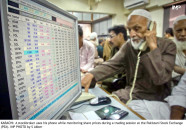Pakistan’s digital landscape post-Covid
Digital connectivity has improved as organisations invest in improving consumer experience

Digitisation is one of the key buzzwords in the post-Covid world. From online shopping for basic commodities to the digitisation of banking transactions, Pakistan has shifted towards an online mode.
The pandemic has revealed the real potential of digital payments and mobile wallets and the current environment provides an excellent opportunity for fintechs to operate and ramp up their contribution to the country’s gross domestic product (GDP) growth.
The State Bank of Pakistan (SBP) is also strongly driving the initiative and has recently launched a micro-payments gateway named Raast designed to ensure financial inclusion for the masses and trigger a wave of digital payments.
How quick are we able to deploy and is the response of the market is yet to be seen but it is certainly a big step in the right direction.
A look at the digital landscape without mentioning the Roshan Digital Account (RDA) would be unfair. This initiative has changed the perspective of overseas Pakistanis on the financial system and has lent credence to the overall digital agenda.
Linking into this, the Securities and Exchange Commission of Pakistan (SECP) has provided guidelines and mechanism to simplify the digital onboarding of clients in the capital markets and mutual funds space.
Digital connectivity has improved substantially over the last few years and organisations have invested heavily in improving consumer experience and creating an efficient and reliable system in the world of transactions.
This is especially evident in e-commerce, fintech and e-government services. Activities that were time-consuming happen now at the click of a button. Excise payments, fund investments and insurance payments have now been simplified.
Other than the ease of use, another key reason for their acceptability is the sense of security provided to the everyday consumers given that they don’t have to travel with cash in hand, which is an increasing problem in the country due to a high crime rate.
QR codes have made their advent in Pakistan but their use is yet to become a norm in daily transactions. Crowd-funding and peer-to-peer (P2P) transactions would take centre stage as investors find ways to simplify the process and make the transaction flow cost effective.
Mobile wallets have penetrated well within the low-income segment and their acquisition has been exponential.
With a young demography and increasing tech-savvy population, mobile phone devices would take centre stage and become the primary tool for payments.
As the system evolves, the next generation of electronic payment systems should do away with the need for smartphone and internet connectivity. The central bank and the Pakistan Telecommunication Authority (PTA) are working together and a pilot project under the Asaan Mobile Account is already under way.
Hopefully, as the road is paved, this would simplify the account-opening process, increase penetration of accountholders and act as a bridge between the mobile wallets and bank accounts. We should soon see an era where mobile balances would be used for shopping and other such everyday transactions.
Study of digital age
A latest survey tilted “Banking in the Digital Age: Exploring Pakistan’s Potential”, conducted by PwC in partnership with AF Ferguson & Co, provides some interesting statistics about the digitisation level of economy.
Around 75% of survey respondents engage in mobile banking activities at least once a week while only 3% of population undertakes weekly visit to a bank branch.
Within the alternative channels, ATM was widely used by 84% of respondents while use of internet and mobile banking stands at around 55% and 67% respectively.
Interestingly, the challenge remains within the use of phone banking where the penetration level is substantially low at 17%.
Millennials and Generation Z were the most sensitive regarding “time to serve” with 66% requiring this to be the top requirement from banks. Physical ambience was low on the list of detractors, accounting for only 11%.
Online marketplaces account for 74% of online transactions while social media platforms contribute a mere 17% of the transactions.
As a key incentive to switch from physical to digital channels, 57% cited customer care while service agility and mobile banking proposition account for 35% and 38% respectively. Some 35% of respondents were worried about security as a key factor in deciding their digital interaction route.
One of the key deterrents to acceptability is the increased threat of fraud and the lack of trust in cyber-security steps taken by institutions. The role of information security would become increasingly important and banks and financial institutions are now compelled to invest in having a strong investment security officers’ team onboard.
Similarly, the regulatory environment has to be strengthened by virtue of consumer protection laws at the federal and provincial levels.
As the key to any digitisation initiative, Pakistan, as a state, will have to ensure that the financial system remains immune and does not become more susceptible to attempts of money laundering and terror financing.
The writer is a student of behavioral finance, a treasury & wealth management professional and a visiting faculty at IBA
Published in The Express Tribune, February 1st, 2021.
Like Business on Facebook, follow @TribuneBiz on Twitter to stay informed and join in the conversation.



















COMMENTS
Comments are moderated and generally will be posted if they are on-topic and not abusive.
For more information, please see our Comments FAQ